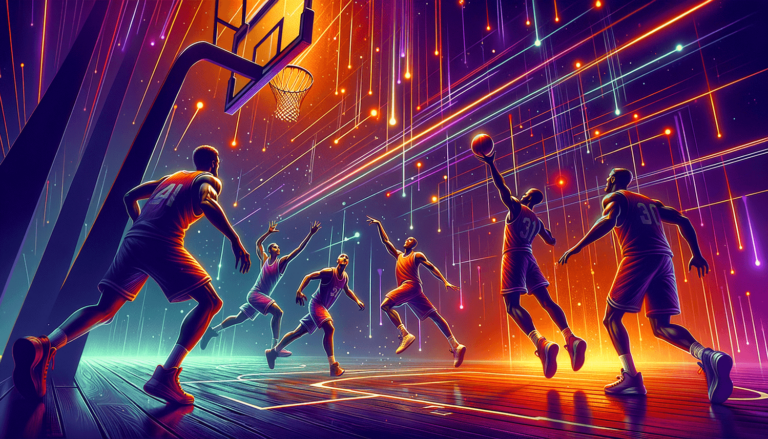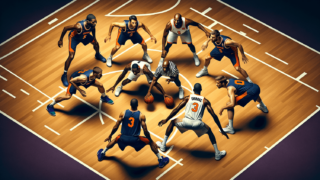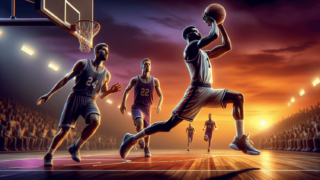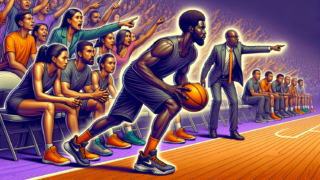
How to Score More in Basketball?
Written by: Basketball Universe
Last updated:

Welcome to the exciting world of basketball, where every point matters! If you’ve been yearning for ways to elevate your game and etch your name in the annals of hoops greatness, you’ve come to the right place. In this blog post, we’ll explore tried-and-true methods to light up the scoreboard, diving deep into a treasure trove of tips, tricks, and best practices. So, whether you’re a budding basketball star or a seasoned veteran looking to supercharge your scoring prowess, grab your favorite pair of sneakers and get ready to unlock the secrets to racking up points like never before!
How to Score More in Basketball?
To score more in basketball, focus on improving your shooting accuracy and shot selection, mastering layups, and enhancing your off-the-ball movements. Developing your ball-handling skills, incorporating a balanced offensive strategy, and cultivating teamwork also contribute to higher-scoring opportunities. Lastly, prioritize your physical conditioning and mental preparation to stay sharp and persistent throughout the game.
The Art of Shooting: Precision and Decision Making
When it comes to point production, there’s no substitute for a perfect shooting technique. To score more in basketball, focus on improving your shooting fundamentals and shot selection. Let’s break this down into key components:
1. Develop a Consistent Shooting Form:
Building a consistent shooting form is fundamental to making more shots. Focus on maintaining balance, holding your follow-through, and keeping your eyes on the target. Set up a shooting routine that includes practice sessions with various shot types, such as jump shots, free throws, and three-pointers. Do this under different scenarios to ingrain a consistent, high-quality shooting form in your muscle memory.
2. Improve Shot Selection:
Make a habit of taking shots you’re comfortable and proficient with. To score more in basketball, take your best shots within your team’s offensive system. Work on analyzing defensive weaknesses to exploit high-percentage shot opportunities. Understand your own shooting strengths and limitations, and leverage them to your advantage when making shot decisions.
Mastering Layups: Close-Range Scoring
Layups are essential tools in any scorer’s arsenal. They’re easy points that add up quickly, and honing your skills can have a significant impact on your game.
1. Practice Ambidexterity:
Improve your layup proficiency by practicing with both hands. It’s crucial to be equally comfortable with right and left-handed layups. This versatility ensures that you can always take the most optimal close-range shot, regardless of defensive positioning.
2. Work on Different Layup Techniques:
There is a wide range of layup techniques that can help you score more points. Spend time perfecting different styles, such as the finger roll, reverse layup, and Euro step. Diversifying your layup game can make your offense harder to read and defend, resulting in more scoring opportunities.
Off-the-Ball Action: Cutting and Screening
Basketball isn’t just about what you do with the ball in your hands; off-the-ball movements play a prominent role in scoring. By mastering cutting and screening techniques, you can create open shots for yourself and your teammates.
1. Smart Cutting:
Learn to read defenses and recognize when it’s the right time to cut to the basket. Often, a sharp cut can catch defenders off guard, enabling you to score easy layups or higher-percentage shots. Make a habit of sprinting towards the hoop and calling for the ball when you notice an opening in the defense.
2. Effective Screening:
Setting strong screens for teammates can also generate easy basket opportunities. By effectively screening defenders, you can create space for your teammates to shoot, drive, or pass the ball. Additionally, your defender may get caught in the screen, leaving you open for a shot, pass, or drive to the basket.
Pivotal Point Production: Developing Ball-Handling Skills
Ball-handling skills are vital to any serious basketball player, as they permit better control and maneuverability on the court. By enhancing your dribbling abilities, you’ll be able to create more scoring opportunities for yourself and your teammates.
1. Dribble with Intent:
Dribbling should have a purpose, whether it’s reducing pressure, moving the ball up the court, or setting up a play. Practice dribbling with intent, focusing on your speed, change of direction, control, and balance. Develop an array of moves that help you beat defenders and maintain control of the ball.
2. Limit Turnovers:
Avoid losing possession of the ball by minimizing turnovers. Turnovers hurt your team’s chances of scoring while also providing your opponents with more opportunities to score. Concentrate on maintaining composure under pressure and making smart decisions with the ball.
Full-Court Finesse: A Balanced Offensive Strategy
A balanced offensive strategy is key to scoring more points in basketball. By attacking various areas of the court, you’ll keep the defense guessing and create scoring chances in different ways.
1. Drive and Kick:
One effective offensive option is the drive and kick. Driving to the basket draws attention from defenders, which can free up your teammates for open shots. Practice driving to the hoop and then kicking the ball out to a teammate for an open three-pointer or mid-range jumper.
2. Pick and Roll:
The pick and roll is a classic basketball play that can significantly boost your team’s scoring potential. In this two-player maneuver, one player sets a screen for a teammate with the ball, who then dribbles around the screen, forcing the defenders to navigate through it. The screener then rolls towards the basket, creating an open scoring chance for themself or their teammate.
Teamwork and Communication: Uniting for Success
While individual talents are crucial for scoring in basketball, no player can achieve greatness without effective teamwork and communication. By working cohesively with your teammates, you’ll open up more paths to score and increase your overall success on the court.
1. Sharing the Ball:
Maintain a selfless attitude on the court and be willing to share the ball. By moving the ball quickly and efficiently, your team can create open shots for each other. Emphasize the value of team chemistry, trust, and communication in fostering a strong offensive unit.
2. Adapt to the Game:
Improve your basketball IQ and learn to adapt to the flow of the game. Be prepared to adjust both offensively and defensively to counteract opposing strategies. By adapting to the opposition and staying versatile, you’ll create more scoring opportunities for yourself and your team.
Physical Conditioning and Mental Preparation: The Winning Edge
Physical conditioning and mental preparation play a critical role in a player’s ability to score more points in basketball. A well-conditioned athlete with a strong mindset is more likely to thrive under pressure and contribute consistently to their team’s scoring.
1. Endurance and Strength Training:
Maintaining peak physical fitness is essential for basketball performance. Focus on endurance and strength training to build a strong foundation. Incorporate running, weightlifting, and plyometric exercises into your routine to improve speed, strength, and explosiveness on the court.
2. Mental Preparation:
To boost your performance on the court, fine-tune your mental game. Cultivate confidence, focus, resilience, and a positive attitude to better handle high-pressure situations. Dedicate time to sharpen your mental fortitude, such as practicing mindfulness techniques or engaging in visualization exercises.
By putting these tips into action, you’ll be well on your way towards becoming a high-scoring basketball superstar. Stay persistent, and above all, enjoy the journey!
Drills and Exercises: Practicing with Purpose
Drills and exercises custom-tailored to your scoring goals can help you become an all-round offensive machine. By focusing on key skills and basketball fundamentals, you can ingrain winning techniques to increase your points production.
1. Solo Shooting Drills:
Use solo shooting drills to develop accuracy and consistency. Try the ‘Around the World’ drill, where you shoot from multiple spots around the three-point line, or the ‘Mikan Drill’, designed to improve your close-range accuracy and layup skills. Allocate time to practice your jump shots, mid-range shots, and free throws, ensuring that you cover all aspects of your shooting game.
2. Dribbling Exercises:
Boost your ball-handling capabilities with purposeful dribbling exercises. Incorporate the ‘Two-Ball Dribble’ drill, where you dribble two basketballs simultaneously, and the ‘Figure 8’ drill, which focuses on hand-eye coordination and hand speed. These exercises train your brain and muscles to work together, helping you build a stronger and more reliable dribbling game.
3. Agility and Footwork Drills:
Agility and footwork are critical factors in a player’s ability to create open shots and move effortlessly around the court. Practice exercises like speed ladder drills and cone agility drills to improve your foot speed, coordination, and acceleration. Consistent work on your speed and agility can lead to more efficient offensive movements and better scoring opportunities.
Essential Gear: The Right Tools for the Game
Having quality basketball gear is necessary to maximize your performance and gain an edge on the court. Rely on professional recommendations when selecting your gear, and make sure to maintain it properly.
1. Basketball Shoes:
Select high-quality basketball shoes that offer cushioning, support, and grip. Your choice should be comfortable, fit well, and cater specifically to your playing style: lightweight for guards, supportive for forwards, and a blend of both for all-rounders.
2. Basketball:
Invest in a high-quality game ball for practice and games. Go for well-regarded brands that provide exceptional grip, durability, and balance. Remember to check the ball’s air pressure regularly, and store it in a cool, dry place when not in use.
3. Training Aids:
Employ training aids, such as speed ladders, resistance bands, and weighted vests, to advance your game. These helpful tools can increase your strength, speed, and agility, ultimately contributing to your scoring capabilities.
Study the Game: Learn from the Masters
Lastly, become a student of basketball – with a wealth of knowledge at your fingertips, learn from the best players and coaches in history. Studying their techniques and strategies can provide valuable insights for improving your game.
1. Watch Game Footage:
Revisit classic games, analyze highlights, and dissect play-by-play videos to observe exceptional scorers in action. Pay attention to their on-court habits and decision-making to understand the nuances behind their success.
2. Read Books and Articles:
Immerse yourself in basketball literature, such as instructional books, articles, and biographies, to uncover a treasure trove of knowledge. Delve into the insights and wisdom of legendary players, coaches, and analysts to acquire unique perspectives on scoring more in basketball.
3. Participate in Training Camps and Workshops:
Attend basketball training camps and workshops to hone your skills, learn from professionals, and network with other basketball enthusiasts. These learning opportunities offer intensive, hands-on coaching and can drastically enhance your overall performance on the court.
Armed with these additional tips, you’re sure to elevate your scoring game and make a lasting impact on the hardwood. Never forget that the pursuit of excellence is an ongoing process, so stay committed, embrace the grind, and enjoy the thrill of your basketball journey!
Frequently Asked Questions: Scoring More in Basketball
It’s natural to have queries and concerns as you aim to elevate your scoring game. Check out our comprehensive FAQ section, addressing some common questions related to increasing your scoring success in basketball.
1. How can I improve my shooting range?
To improve your shooting range, strengthen your shooting mechanics, focusing on proper technique, balance, and follow-through. Additionally, incorporate muscle-strengthening exercises, such as wrist curls and shoulder presses, into your workout routine to increase power and shooting distance.
2. What percentage of my practice time should focus on shooting?
While there’s no fixed percentage, a significant portion of your practice time must be dedicated to shooting, as it directly impacts your scoring. Aim to dedicate around 40-50% of your practice to shooting drills, working on various shot types and ranges. Remember to balance your training with ball-handling, defense, and conditioning drills.
3. How do I become more consistent in making shots?
Consistency in making shots is achieved through regular, focused practice that emphasizes proper shooting techniques. Develop a consistent shooting form and routine to build muscle memory, allowing you to shoot accurately under any circumstance. Additionally, mental conditioning is crucial; cultivate a positive mindset and confidence in your abilities.
4. Can shooting with a smaller ball help increase accuracy?
Shooting with a smaller ball can be a useful training exercise to boost your accuracy. Using a smaller target magnifies any inconsistencies in your shooting technique, helping you refine your shooting form and develop better hand-eye coordination.
5. How do I improve my quickness on the court?
Improving your quickness on the court involves a combination of strength training, agility exercises, and plyometrics. Focus on developing explosive power in your lower body, and incorporate agility drills, such as speed ladders and cone drills, to enhance foot speed and coordination.
6. Which muscle groups are most important for increasing scoring ability?
For increasing scoring ability, prioritize strengthening your core, lower body, and upper body. Develop a well-rounded workout routine, targeting muscles such as the quadriceps, hamstrings, glutes, calves, abdominals, lower back, biceps, triceps, and shoulders. A strong foundation contributes to better stability, balance, and explosiveness on the court.
7. How do I become better at reading defenses?
To become better at reading defenses, study game footage, and analyze defensive schemes. Practice identifying various defensive tactics, such as man-to-man, zone, and full-court press. Developing a deeper understanding of defensive strategies helps you exploit weaknesses and make smarter decisions on the offensive end.
8. How can I reduce turnovers during a game?
Reducing turnovers depends on improving your ball-handling skills, decision-making, and communication with teammates. Practice dribbling techniques, keep your head up while dribbling, and develop your basketball IQ. Learn to handle pressure, make smart passes, and stay composed under pressure to minimize turnovers.
9. What’s the ideal shot selection in a game?
Optimal shot selection varies for each player and depends on factors such as individual skill level, defender positioning, and team strategy. Ideally, aim for high-percentage shots that cater to your strengths, exploit defensive weaknesses, and fit within your team’s offensive scheme.
10. How can I increase my vertical leap for better scoring opportunities?
Increasing your vertical leap involves strengthening your lower body muscles and enhancing your explosive power. Implement exercises like squats, lunges, box jumps, and plyometrics into your training routine. Additionally, focus on flexibility and proper jumping mechanics to improve your vertical leap and maximize scoring opportunities.
11. How do I improve my offensive rebounding skills?
Improving offensive rebounding requires anticipation, positioning, and tenacity. Work on reading shot trajectories to anticipate where the ball might land, position yourself accordingly, and box out your opponents. Develop your jumping ability and maintain an aggressive mindset when pursuing offensive boards.
12. How can I develop a quicker first step?
Developing a quicker first step involves increasing your lower body strength and explosiveness. Incorporate plyometric exercises, resistance band training, and agility drills to build power in your legs and feet. Improving your first step quickness can help you blow past defenders and create better scoring opportunities.
13. What are some effective pre-game warm
Featured Posts
- No pillar pages found.





